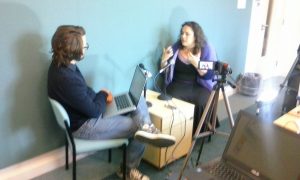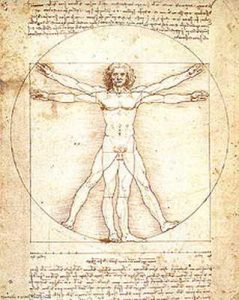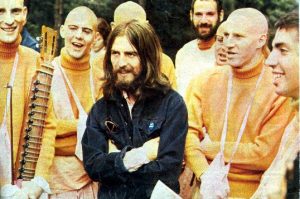BDSM as Religious Practice
 In this interview Alison Robertson gives an insight to her doctoral research on BDSM (Bondage, Dominance, and Submission) as religious practice. Throughout her research, Robertson has examined the relationship between BDSM and religiosity, drawing interesting questions on the nature of religion as a category, the role of self-inflicted/positive pain in religious practice.
In this interview Alison Robertson gives an insight to her doctoral research on BDSM (Bondage, Dominance, and Submission) as religious practice. Throughout her research, Robertson has examined the relationship between BDSM and religiosity, drawing interesting questions on the nature of religion as a category, the role of self-inflicted/positive pain in religious practice.
 This interview considers the methods of approaching a study of BDSM, the dreaded ethical clearance, and interview participants' responses to the categorization of their experience as 'religious'. Robertson's research poses important questions for the wider academy, including what other 'extreme' practices could be deemed religious, and the difficulty in identifying differences between 'religious' and 'spiritual' experiences.
This interview considers the methods of approaching a study of BDSM, the dreaded ethical clearance, and interview participants' responses to the categorization of their experience as 'religious'. Robertson's research poses important questions for the wider academy, including what other 'extreme' practices could be deemed religious, and the difficulty in identifying differences between 'religious' and 'spiritual' experiences.
The “Axial Age”: Problematising Religious History in a Post-Colonial Setting
Karl Jaspers created the term “Axial Age” in 1949 after considering that the Bhagavad Gita, the Pali Canon, the Book of Isaiah, the Book of Jeremiah, the writings of Plato and Aristotle, the Daodejing, and the Analects of Confucius were just a few of the philosophical and theological texts penned in the middle centuries of the first millennium BCE. For Jaspers, this collection of philosophical and theological works was a sign of an era of social and intellectual maturity, a maturation that Jasper felt left simpler formulations of such thinking in its wake. The notion of the “Axial Age” has held through to the 21st century, the most recent manifestation of the theory being seen in Robert N. Bellah’s 2012 monograph Religion and Human Evolution: From the Paleolithic to the Axial Age.
 To discuss the “Axial Age”, its consequences, credibility, and critiques, Breann Fallon sat down with long-time team-member of the Religious Studies Project, Dr Jack Tsonis. Dr Jack Tsonis has recently taken up a position at Western Sydney University, teaching the Masters of Research Program. They discuss the origin and historiography of the term “Axial Age” before diving into an analysis of the term as used in Religious Studies. Tsonis gives a fiery critique of the racial, ethnic, and religious stereotypes upon which the term is founded, and the subsequent need for avoidance of the term “Axial Age” and all that it embodies. Later, they discuss the difficulties of the immediate post-PhD years, particularly the delicate research-teaching balance, resulting in some useful advice for anyone in their final PhD months or for those who have recently submitted.
To discuss the “Axial Age”, its consequences, credibility, and critiques, Breann Fallon sat down with long-time team-member of the Religious Studies Project, Dr Jack Tsonis. Dr Jack Tsonis has recently taken up a position at Western Sydney University, teaching the Masters of Research Program. They discuss the origin and historiography of the term “Axial Age” before diving into an analysis of the term as used in Religious Studies. Tsonis gives a fiery critique of the racial, ethnic, and religious stereotypes upon which the term is founded, and the subsequent need for avoidance of the term “Axial Age” and all that it embodies. Later, they discuss the difficulties of the immediate post-PhD years, particularly the delicate research-teaching balance, resulting in some useful advice for anyone in their final PhD months or for those who have recently submitted.
ISKCON In Britain
This year the ISKCON Movement (International Society for Krishna Consciousness) celebrates its 50th anniversary. Fittingly, for this podcast Kim Knott provides an overview of the Hare Krishna movement in Britain from its inception in 1966 to the present day.
Recognisable by their distinctive appearances and chants, ISKCON practitioners grew in number in the UK due to a number of reasons, ranging from young people's fascination with Indian spirituality in the 1960s, to its celebrity endorsements from George Harrison and the Beatles.
Knott considers the most notable events in ISKCON's fifty year history in Britain, and discusses how the movement has adapted to British lifestyle, and what the future may hold for ISKCON education.
ISKCON And When New Religions Aren’t So New Anymore
As a follow-up to our interview with Kim Knott on ISKCON in Britain, this podcast is a roundtable discussion at the ISKCON 50 conference at Bath Spa University, 2016.
During this roundtable, scholars consider the subjective nature of the term 'new' in the study of New Religious Movements. Using the particular movement of ISKCON (International Society for Krishna Consciousness) as their main example, panelists consider the future of the movement and similar NRMs in contemporary society, the limitations of the category of 'NRM', and what the future may pose for the academic study of movements such as ISKCON.
The RSP want to thank Bath Spa University for supporting these recordings, especially to Catherine Robinson and Alan Marshall.
Embodied religious practices, child psychology and cognitive neuroscience
 In this interview, Brock Bahler, visiting assistant professor in Religious studies at the University of Pittsburgh, talks about his research on cognitive neuroscience, child psychology and embodied religious practices. Through the philosophy of Merleau-Ponty, Descartes, and Levinas on the relationship between the mind and the body, Bahler discusses the notion of ritual as a locus of power in terms of structure and agency. His recent book, Childlike Peace in Levinas and Merleau-Ponty: Intersubjectivity as a Dialectical Spiral (Lexington Books, forthcoming) focuses on neuroscience to grasp the topic power relations at the confluence of religion and other social influences on one’s trajectories. As such, Bahler examines, with a “phenomenological twist”, what rituals do in terms of education, psychology, and subjectivity.
In this interview, Brock Bahler, visiting assistant professor in Religious studies at the University of Pittsburgh, talks about his research on cognitive neuroscience, child psychology and embodied religious practices. Through the philosophy of Merleau-Ponty, Descartes, and Levinas on the relationship between the mind and the body, Bahler discusses the notion of ritual as a locus of power in terms of structure and agency. His recent book, Childlike Peace in Levinas and Merleau-Ponty: Intersubjectivity as a Dialectical Spiral (Lexington Books, forthcoming) focuses on neuroscience to grasp the topic power relations at the confluence of religion and other social influences on one’s trajectories. As such, Bahler examines, with a “phenomenological twist”, what rituals do in terms of education, psychology, and subjectivity.
Historical, Popular, and Scholarly Constructions of Yoga
In this interview, we discuss the history and development of yoga in its South Asian contexts, and then examine its transformations across the globe into the contemporary era.
In its earliest uses, the word “yoga” meant “yoke,” primarily yoking a warhorse to a chariot. In the classical period, yoga took on a variety of other meanings, including yoking the mind-body complex through meditative practices, such as breath control and mantras, to achieve liberation. Yoga was an analysis of perception and cognition, whereby to know something is to be it; higher states of consciousness could expand individuals into the universe and even to omniscience. Yoga also included achieving superpowers through sexual and other bodily alchemical practices, allowing practitioners to see through things and to take over other human bodies. In tantric yoga, which developed during the medieval period, the goal became not union with the absolute but rather to become a living god, a yogi, through occult practices. In hatha yoga, practitioners regulated their breath and channeled vital fluids within the body, via chakras, in order to achieve awakening and supernatural powers. Contemporary forms of yoga as postural practice developed from Hindu Vedanta, Indian nationalism, the Orientalist resurrection of the Yoga Sutras, Theosophy, Swedish gymnastics, and other sources, and constitute a relatively recent phenomenon in the history of yoga. Even more recently, the study of yoga in North America has been riven by debates about what counts as “authentic” yoga and who gets to make such claims authoritatively, as the Hindu America Foundation’s Take Back Yoga campaign can attest.
Global(ized) religion and the study of religious tensions
This interview with global studies pioneer Mark Juergensmeyer takes on his keynote address at the 2016 Eastern International Meeting of the American Academy of Religion (EIR-AAR) at the University of Pittsburgh. Starting from a historical and comparative study of religion, Juergensmeyer advocates for a new approach to religion, as it exists today in a globalized framework. As such, in his most recent book, God in the Tumult of the Global Square (2015), he examines the ethical and moral dimensions brought on by environmental changes concerning religious people, spiritual, but not religious people, and the people who identify with none of those categories alike. He interrogates the intersections of different religions traditions, questions the world religion paradigm as taught in universities today, and examines new phenomena caused by decentralized localized antiauthoritarian characteristics of globalization.
Categorising “Religion”: From Case Studies to Methodology
The category of “religion” is often referred to as slippery or problematic. As such, scholars have sought to deconstruct the term in order to be free of its weight. But what happens after the deconstruction – where we go from there? How do we study particular cases? How are new groups officially recognised? What roles to scholars play in the application of the term to new groups? In this interview, Dr Teemu Taira discusses the role of marginal traditions in understanding the application of the term "religion" in differing context, in particular he discusses Karhun Kansa, the People of the Bear. This leads onto a methodological discussion on the use of the term and the role scholars play in this discourse.
Want to check out all of the great responses Taira's podcast has prompted?
- "The Deconstruction of Religion: So What?"
- "Theoretical Veganism: Practicing Religious Studies without Religion"
- "Whither the Study of Religion and Culture?"
- "On deconstructing the deconstruction of the deconstruction of the category of religion"
- "'What happens after the deconstruction?'"
- "The Blind Leading the Seeing"
- "Shivers Up My Spine"
Related podcasts:
An Introduction to the Sociology of Religion
What is the sociology of religion? What are its particular concerns, dominant themes and defining methodologies? Where did it begin, and how has it evolved? This interview with Grace Davie introduces this important and historically influential approach to the study of religion.
In conversation with David G Robertson, Professor Davie - herself a highly respected theorist of religious change - discuss the four tasks of the sociology of religion; some early sociologists and their relationship to the social changes of their time; modernity, secularisation and a more recent social shift, the Internet; and how Europe may be the exception in the modern world, rather than the model by which all other states will necessarily proceed. They conclude by reminding listeners that we must always keep our theories foremost in our thinking, because they are as socially and historically contextual as the data we use them to interpret.
Consider next: The Changing Nature of Religion, or our podcasts on Emile Durkheim, Claude Levi-Strauss, Religion, Neoliberalism and Consumer Culture, Marxist Approaches, Bricolage and more...
Communism and Catholicism: Religion and Religious Studies in Lithuania
Under Communism, religion was suppressed in the formerly Catholic Eastern European country of Lithuania until the 1990s. Milda Ališauskienė tells David Robertson about the religious field like in a country where religion was banned for half of the 20th century. Do we see a simple resurgence of Catholicism, or something more complex? What about New Religious Movements - are there new forms of vernacular Lithuanian religious expression? How does immigration affect this field?
 The second half of the interview discusses the practicalities of how you go about setting up and running a Religious Studies department in a post-Soviet country such as Lithuania. While there was no academic study of religion during the Soviet era, this has also affected the public perception of the need for such a study. This interview presents a fascinating inside look at the study of religion between two hegemonies - Communism and Catholicism.
The second half of the interview discusses the practicalities of how you go about setting up and running a Religious Studies department in a post-Soviet country such as Lithuania. While there was no academic study of religion during the Soviet era, this has also affected the public perception of the need for such a study. This interview presents a fascinating inside look at the study of religion between two hegemonies - Communism and Catholicism.



